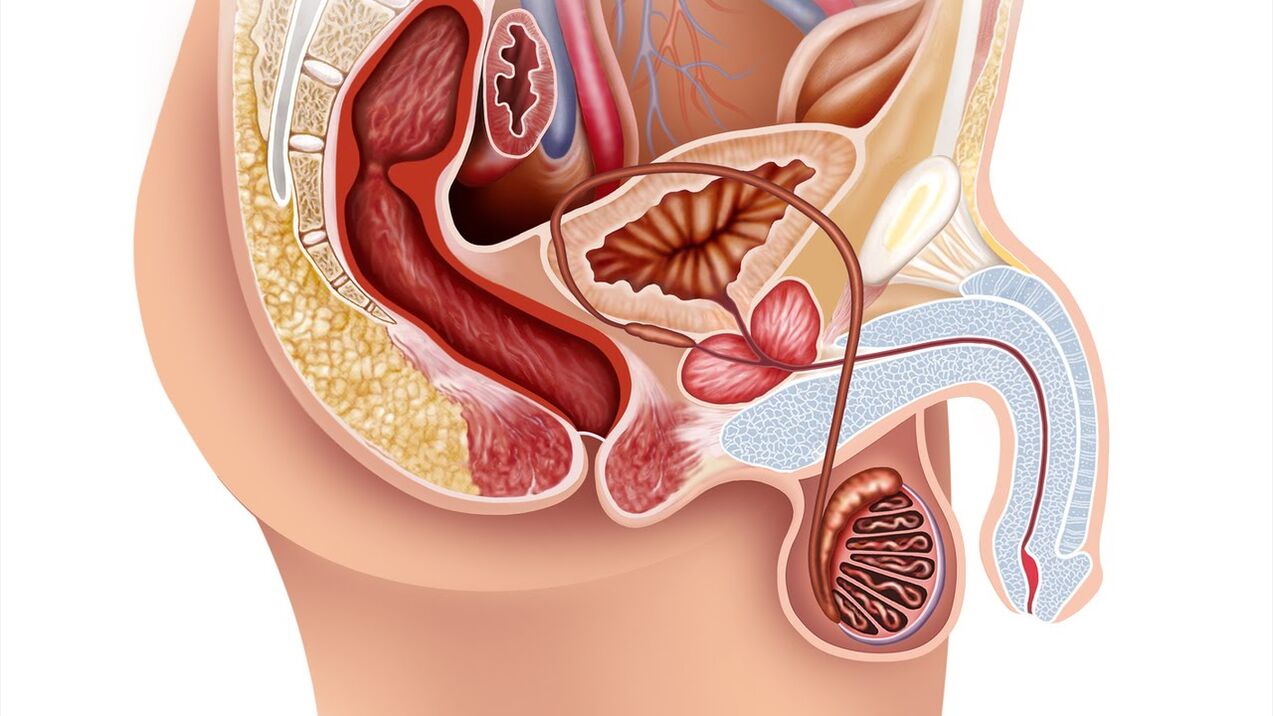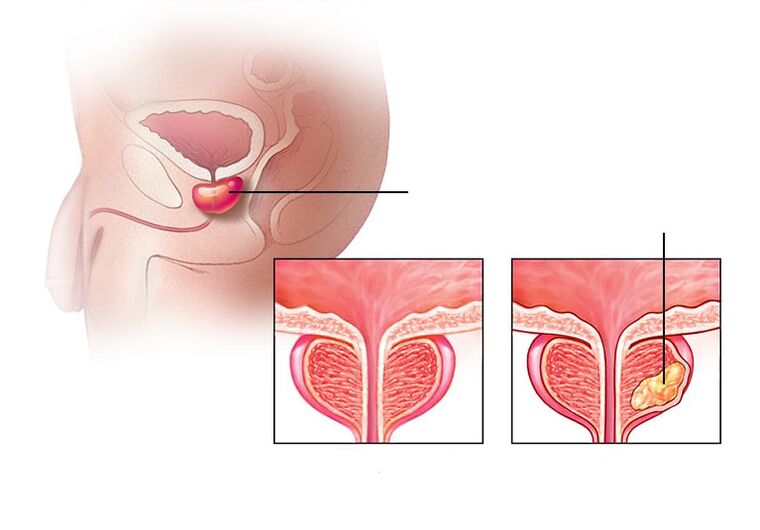
Prostatitis is an inflammatory process associated with inflammation of the prostate (prostate) in men. Most often, this disease occurs in men over 30 years old. This condition causes pain in the lower back, perineum or pelvic region, is accompanied by a violation of the normal process of urination, and in severe forms leads to erectile dysfunction and serious problems in relations with apartner.
About a quarter of the cases in couples suffering from infertility are precisely the causes of the male factor that affect the impossibility of conceiving. Male infertility is a violation of the quality of sperm and their quantitative content in the ejaculate.

The prostate gland (prostate) refers to the male reproductive system. It has the shape of a chestnut, located in front of the rectum, under the bladder and surrounds the urethra (urethra). When the prostate becomes inflamed, it compresses the urethra, leading to problems with urination. The main function of the prostate is to produce a secret (liquid) that is part of the semen and dilutes it, which ensures the normal motility of sperm.
Prostatitis is very common in the practice of a urologist. It can occur suddenly or gradually, appear constantly and for a long time (chronic prostatitis). The chronic form of this disease is more common than the acute form. Chronic prostatitis ranks fifth among the top twenty urological diagnoses.
Since prostatitis is an active focus of infection in the body, it requires mandatory treatment, even if its symptoms do not bother you.
Reasons for the development of prostatitis
The list of causes that cause inflammation of the prostate is very varied:
- diseases of the genitourinary system (cystitis, urethritis, pyelonephritis);
- sexually transmitted infections (trichomoniasis, gonorrhea);
- infections associated with pneumonia, influenza, tonsillitis, furunculosis;
- chronic constipation, forcing a man to exercise regularly;
- sedentary lifestyle and irregular sex life, which lead to stagnation of secrecy;
- urinary retention - a swollen bladder increases pressure on the prostate;
- frequent hypothermia (or overheating);
- injuries in the pelvic region;
- hormonal disorders that weaken the immune system.
Very often, the appearance of prostatitis is caused by pyogenic microbes: E. coli, streptococci and staphylococci, mycoplasma, Candida fungi, Trichomonas, tubercle bacillus. They multiply very quickly and destroy prostate tissue, which is manifested by inflammation.
In most cases, the occurrence of prostatitis causes an infection entering the prostate through the urethra. It happens that it enters the body through blood or lymph, passes from the bladder or rectum.
Important! A decrease in immunity is very dangerous for a patient with chronic prostatitis, since the prostate quickly becomes inflamed by fatigue, stress, lack of sleep, malnutrition and other undesirable factors.
With a sedentary lifestyle and the absence of a constant sex life, the blood supply to the pelvic organs worsens, which leads to oxygen starvation of the prostate tissues and congestion. A stagnant secret is an ideal environment for the development of pathogenic microorganisms that cause inflammation.

Types and forms of prostatitis
Prostatitis, depending on the cause of the disease, is classified into types and forms:
By type, we distinguish:
bacterial prostatitis- Inflammation caused by an infection. Bacterial prostatitis occurs in young and old men.
congestive prostatitis- inflammation caused by stagnation of secretion. It develops in men with a sedentary lifestyle who do not have a regular sex life. This form can quickly be supplemented by infection, then the stagnant process is complicated by the bacterial form.
Calculous prostatitis- stones form in the prostate. Untreated chronic prostatitis can cause this complication. This disease affects older men who have not followed the advice of a urologist.
According to the form of flow, we distinguish:
Acute form of prostatitis- it is an inflammation of the prostate caused by an infectious agent, characterized by the appearance of edema and purulent foci in the tissues. 30 to 58% of men of childbearing age (30 to 50 years old) are faced with such a diagnosis.
Chronic form of prostatitischaracterized by persistent or recurrent urogenital symptoms caused by bacterial infection of the prostate. The chronic form occupies 10% of all cases of prostatitis.
Symptoms of prostatitis
Generalsymptoms of prostate inflammationare:
- pain in the lumbar region;
- feelings of discomfort during intestinal motility;
- pain in the perineum or pelvic area;
- labor disorders of the lower urinary tract.
The acute stage of prostatitis is accompanied by a general intoxication syndrome. This disease is characterized by an acute manifestation of symptoms with a vivid clinical picture:
- a sharp increase in body temperature, chills, nausea, vomiting and malaise;
- pain syndrome and chills in the joints and muscles;
- an increase in the size of the prostate and the appearance of discomfort in the perineal area;
- frequent urination and urinary retention.
Against the background of individual inflammatory processes, purulent-septic disease can develop and affect the blood. In such a situation, the patient should be urgently hospitalized: in case of sepsis, treatment of prostatitis should be carried out exclusively in the clinic.
Tochronic bacterial prostatitissymptoms are usually absent, so treatment begins only when an infection of the urinary system is detected, which manifests itself against the background of a complication of the disease. In this case, you can observe:
- pain during ejaculation;
- the appearance of blood in the ejaculate;
- the presence of discharge from the urethra;
- erectile dysfunction may develop.
If the examination did not show that chronic pain is caused by pathologies of the prostate, then in this case we are dealing withnonbacterial chronic prostatitisor the so calledchronic pelvic pain syndrome. With this disease, the quality of life of a man is significantly reduced, as it leads to various disorders of a psychological and sexual nature:
- increased fatigue;
- a feeling of helplessness;
- erectile dysfunction;
- painful ejaculation;
- pain after intercourse, etc.
Similar symptoms can apply to other urological diseases, so it is impossible to diagnose prostatitis by symptoms alone. For example, urination disorders and pain are present in prostate adenoma, cystitis, various oncological tumors of the genitourinary organs, etc.
Diagnosis of prostate inflammation
Having identified the first signs of the inflammatory process in the prostate, the patient should immediately contact a doctor - a urologist. The doctor must exclude many diseases that have similar manifestations and determine what type of disease they belong to.
To confirm that the patient does not have other diseases (for example, appendicitis, oncology, inflammatory processes in the bladder and kidneys, prostate adenoma), the doctor should conduct the necessary examinations:
- collection of anamnesis (examination of the patient);
- General inspection;
- rectal examination;
- study of the secret of the prostate;
- analysis of sexually transmitted infections;
- ultrasound examination of the prostate, scrotum and pelvic organs.
During the appointment, the urologist should clarify with the patient the duration of the clinical manifestations of the disease, the localization and nature of the pain (for example, in the perineum, scrotum, penis and inside of thethigh), characteristic changes in semen (presence of pus and blood).
The doctor establishes the diagnosis of chronic bacterial prostatitis with a duration of symptoms of at least three months.
The investigation will include:
- Digital rectal examination of the gland, to determine the degree of prostate enlargement and its consistency.
- Analyzes of prostatic secretion, urine and/or ejaculate.
- Identification of urogenital infection.
- Urodynamic study.
- Ultrasound examination of the urinary system (kidneys, prostate, bladder with determination of residual urine).
- Culture study of prostatic secretion and microscopy of various portions of urine and prostatic secretion.
- Androflor is an in-depth study of the microbiocenosis of the urogenital tract in humans by PCR, which will determine the qualitative and quantitative composition of the microflora.
After identifying the cause of the disease, the doctor will recommend treatment. It should be remembered that standard methods can detect infection only in 5-10% of cases, which ultimately leads to prostatitis.
The patient should definitely undergo a thorough diagnosis, since the success of treatment will depend on the accuracy of the results.
Treatment of prostatitis
When a urologist has made a diagnosis, determined the cause and form of prostatitis, he should prescribe treatment.
The main role in the treatment of this disease is assigned to drug therapy:
Antibacterial therapy
At the first stage of therapeutic therapy, it is necessary to eliminate inflammation. Antibiotics are the main treatment for acute bacterial prostatitis and are recommended for chronic bacterial prostatitis. The doctor chooses an antibacterial drug depending on the bacteria that caused the disease. The patient will need to take oral antibiotics for 4 to 6 weeks. Chronic or recurring prostatitis takes longer to go away. Hospitalization may be required for very severe manifestations, where intravenous antibiotic therapy will be administered. Usually this happens with acute bacterial prostatitis.
Treatment with alpha1-blockers
If you have difficulty urinating, the doctor prescribes alpha-1 blockers, which help facilitate urination and relax the muscles of the prostate and bladder. Muscle relaxants will relieve pain caused by the swelling of the prostate, which puts pressure on adjacent muscles. Nonsteroidal anti-inflammatory drugs will help relieve the pain syndrome.
Also, the doctor can prescribe auxiliary drugs: biostimulants, extracts of various plants and insects in the form of rectal suppositories. Unfortunately, the use of drugs alone in the treatment of prostatitis remains insufficient.
In the treatment of this disease, the principles of the sequence of actions should be observed. The treatment of prostatitis is always complex.
Physiotherapy in the treatment of prostatitis
In chronic prostatitis categories, you can also use physiotherapy methods:
- prostate massage (prostate);
- laser therapy;
- microwave hyperthermia and thermotherapy;
- electrical stimulation with modulated currents with skin or rectal electrodes;
- acupuncture (acupuncture).
Alternative methods, such as hirudotherapy (treatment with medical leeches), are sometimes used to treat prostatitis, but the effectiveness and safety of this method have not been proven.
Introduction of stem cells
Cell therapy (stem cell injections) is a promising method for the treatment of prostatitis today, it is in the early stages of development. Regarding the injection of stem cells into the prostate, one can only have hypotheses about its mechanisms and empirical data obtained by groups of individual researchers.
Surgical treatment of prostatitis
Surgical methods are used to treat complications of prostatitis (abscess and suppuration of seminal vesicles).
The treatment of chronic pelvic pain syndrome requires a separate review. Asymptomatic inflammatory prostatitis does not require treatment.
Diet and lifestyle for prostatitis
Prostatitis does not require a special diet, but eating plenty of vegetables, lean meat, and dairy products will help improve bowel function. You must enrich your body with a sufficient quantity of fiber, foods rich in vitamin E (wheat germ, corn oil, etc. ), replace sugar with natural honey. Proper nutrition with inflammation of the prostate will help improve bowel function and reduce the risk of relapse or speed up recovery. The patient should limit himself to coffee, exclude alcohol, drink plenty of fluids and adhere to a healthy lifestyle.
Preventive measures to prevent prostatitis
When a man leads the right lifestyle: he follows proper nutrition, plays sports, then his chances of developing chronic prostatitis are very low. Refusal of bad habits and casual sex are the prevention of this disease.
Important! There is primary and secondary prevention to prevent the development of prostatitis in men.
Primary- aimed at preventing the onset of the disease. This means maintaining a balanced diet, a regime of physical activity, timely treatment of any infectious diseases of the body and regular safe sex, etc.
Secondary- is aimed at preventing the recurrence of existing chronic prostatitis and provides for regular examination by a urologist and preventive treatment with multivitamins, restorative drugs and sports.



























